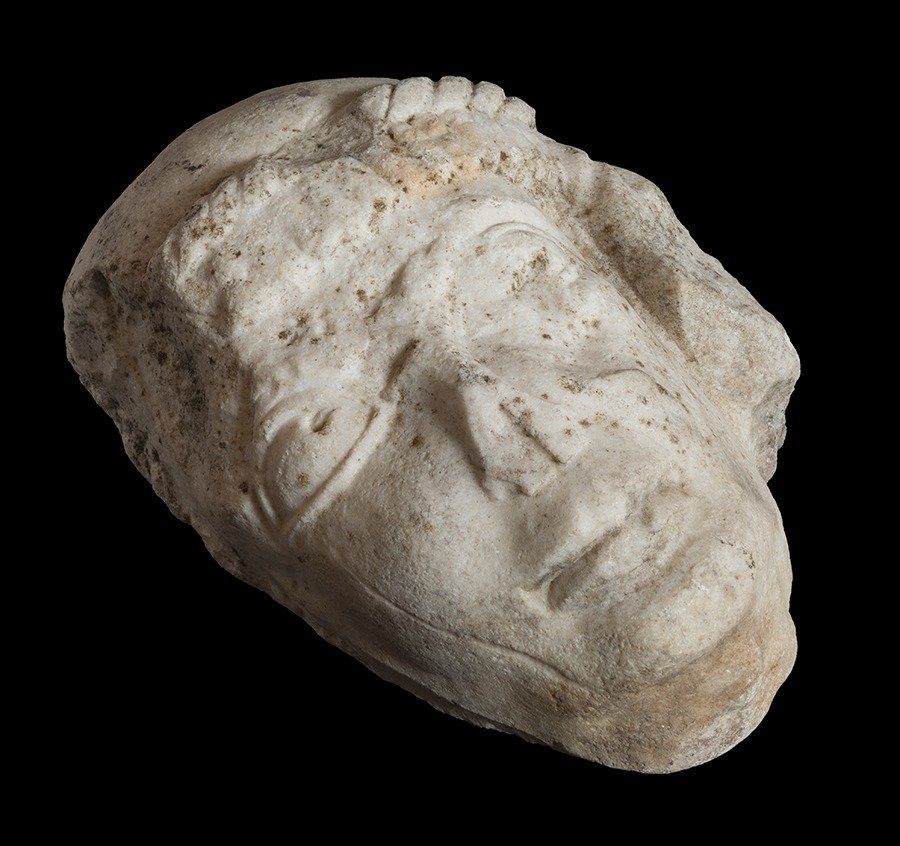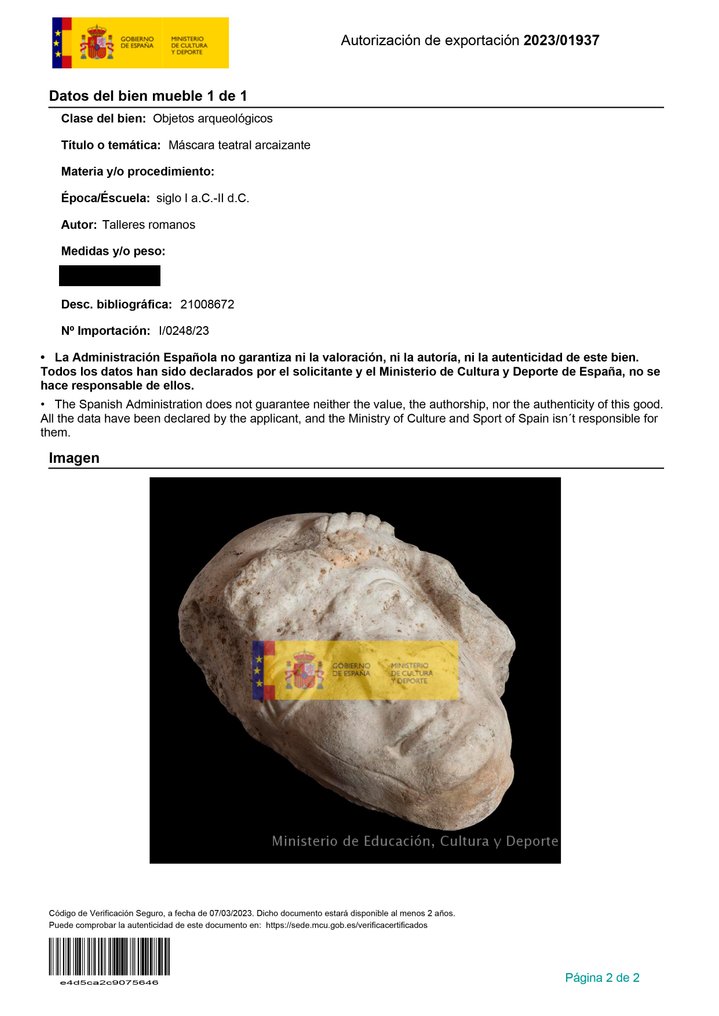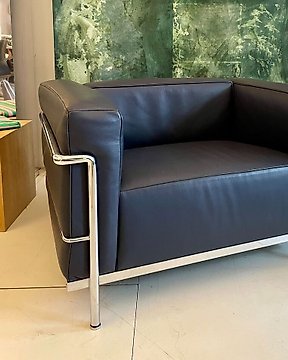Very nice and fine cut little jewel! Well packed too! Thanks!
Fordítás megtekintéseÓkori római Márvány színházi maszk. 29 cm H. Hatalmas és fontos. Spanyol kiviteli engedély.
Nr. 84870893




theatrical mask.
Roman Empire, 1st century B.C. - 2nd century AD.
Material: Marble.
Provenance: Private Collection of Bengt Söderbergh (1925-2019), Cannes, France.
Without restorations.
Measures: 29 x 20 cm.
Theater mask with markedly archaic features, an aspect appreciable in the large almond-shaped eyes, in the hieratism of the face and in the headdress that the personage wears. The ethnologists place the birth of the mask in the moment in which the self-consciousness is produced. Its use dates back to the most distant antiquity, being found among the Egyptians, Greeks and Romans. The Greeks used them in the Dionysian festivities; the Romans during the Lupercal and Saturnalia and also in the scenic representations.
The Romans brought two important innovations to the world of sculpture: the portrait and the historical relief, neither of which existed in the Greek world. However, they followed the Greek models for a large part of their sculptural production, a base that in Rome was combined with the Etruscan tradition. After the first contacts with the Greece of classicism through the colonies of Magna Graecia, the Romans conquered Syracuse in 212 BC, a rich and important Greek colony located in Sicily, adorned with a large number of Hellenistic works. The city was sacked and its artistic treasures taken to Rome, where the new style of these works soon replaced the Etruscan-Roman tradition that had prevailed until then. Cato himself denounced the sacking and decoration of Rome with Hellenistic works, which he considered a dangerous influence on native culture, and deplored the Romans' applauding of statues from Corinth and Athens, while ridiculing the decorative terracotta tradition of ancient Roman temples. However, these oppositional reactions were in vain; Greek art had subdued Etruscan-Roman art in general, to the point that Greek statues were among the most coveted prizes of war, being displayed during the triumphal procession of the conquering generals.
NOTES:
- The piece includes authenticity certificate.
- The piece includes Spanish Export License.
- The seller guarantees that he acquired this piece according to all national and international laws related to the ownership of cultural property. Provenance statement seen by Catawiki.
THE MINISTRY OF CULTURE FROM SPAIN ASKS ALL SELLERS FOR INVOICES OR OTHER DOCUMENTATION ABLE TO PROVE THE LEGALITY OF EACH ITEM BEFORE PROVIDING AN IMPORT OR EXPORT LICENSE.
#ancientcivilisations
Az eladó története
theatrical mask.
Roman Empire, 1st century B.C. - 2nd century AD.
Material: Marble.
Provenance: Private Collection of Bengt Söderbergh (1925-2019), Cannes, France.
Without restorations.
Measures: 29 x 20 cm.
Theater mask with markedly archaic features, an aspect appreciable in the large almond-shaped eyes, in the hieratism of the face and in the headdress that the personage wears. The ethnologists place the birth of the mask in the moment in which the self-consciousness is produced. Its use dates back to the most distant antiquity, being found among the Egyptians, Greeks and Romans. The Greeks used them in the Dionysian festivities; the Romans during the Lupercal and Saturnalia and also in the scenic representations.
The Romans brought two important innovations to the world of sculpture: the portrait and the historical relief, neither of which existed in the Greek world. However, they followed the Greek models for a large part of their sculptural production, a base that in Rome was combined with the Etruscan tradition. After the first contacts with the Greece of classicism through the colonies of Magna Graecia, the Romans conquered Syracuse in 212 BC, a rich and important Greek colony located in Sicily, adorned with a large number of Hellenistic works. The city was sacked and its artistic treasures taken to Rome, where the new style of these works soon replaced the Etruscan-Roman tradition that had prevailed until then. Cato himself denounced the sacking and decoration of Rome with Hellenistic works, which he considered a dangerous influence on native culture, and deplored the Romans' applauding of statues from Corinth and Athens, while ridiculing the decorative terracotta tradition of ancient Roman temples. However, these oppositional reactions were in vain; Greek art had subdued Etruscan-Roman art in general, to the point that Greek statues were among the most coveted prizes of war, being displayed during the triumphal procession of the conquering generals.
NOTES:
- The piece includes authenticity certificate.
- The piece includes Spanish Export License.
- The seller guarantees that he acquired this piece according to all national and international laws related to the ownership of cultural property. Provenance statement seen by Catawiki.
THE MINISTRY OF CULTURE FROM SPAIN ASKS ALL SELLERS FOR INVOICES OR OTHER DOCUMENTATION ABLE TO PROVE THE LEGALITY OF EACH ITEM BEFORE PROVIDING AN IMPORT OR EXPORT LICENSE.
#ancientcivilisations
Az eladó története
- 746
- 7
- 0
nice piece and very fast shipping!
Fordítás megtekintéseEs una maravilla de moneda, donde se le nota los pasos de los años y me encanta. Servido muy rápido y bien empaquetado. Con su certificación. Qué más se puede pedir?
Fordítás megtekintéseSnelle en correcte levering, alleen was de verpakking voor het schilderij niet stevig genoeg.
Fordítás megtekintéseHerzlichen Dank!
Fordítás megtekintéseAll OK and with very fast shipping.
Fordítás megtekintésePrachtig schilderij. Zo blij mee. Zeer nette verkoper en zeer snelle levering.
Fordítás megtekintéseperfect ! very fast and high quality delivery !
Fordítás megtekintéseAll well! Thanks.
Fordítás megtekintéseVendeur très professionnel, top +++×
Fordítás megtekintésePhotos trop contrastées pour bien percevoir les défauts, mais ces défauts étaient visibles pour autant. Le "Bon état" est trompeur. Sinon, envoi rapide et correctement emballé. Frais de port exagérés.
Fordítás megtekintéseGreat communication, delivery and product. Came with a well made certificate of authenticity and good packaging. Overall very happy with the purchase! Delivery is a bit expensive, but I recommend it
Fordítás megtekintéseMagnifique témoin du passé, envoyé avec tous les justificatifs, impeccable. Encore une fois très satisfait, un grand merci
Fordítás megtekintéseThank you for the Special offer and the fast shipping of this excellent piece of art!
Fordítás megtekintésevery good description of the object, very good price for this rare item,. Fast sending (has been at my place 2 days after buying!). Definitely would buy again.
Fordítás megtekintéseSehr schön
Fordítás megtekintéseAs described, perfect logistic
Fordítás megtekintésegreat seller, everything came as should with certificate of authenticity
Fordítás megtekintéseExceptionally well packaged, description aligned with positing received
Fordítás megtekintéseReally precious, but without sound...
Fordítás megtekintésePainting well packed and rapidly sent!
Fordítás megtekintésesempre grande rapidità e professionalità
Fordítás megtekintéseparfait bien reçu, merci
Fordítás megtekintéseVery satisfied with the small Greek Lekythos. As always (we have already bought several items from Bagot), the object was wrapped and sent immediately and with the greatest care.
Fordítás megtekintésePerfect, excellent condition, good packaging, the parcel arrived without any problems… all is perfect as usual. Thank you very much and wait for an other nice piece like this one. Gilles.
Fordítás megtekintése- 746
- 7
- 0
Very nice and fine cut little jewel! Well packed too! Thanks!
Fordítás megtekintéseLemondás
Az eladó garantálja, hogy a tárgy a jogszabályoknak megfelelően került hozzá, és ezt bizonyítani is tudja. Az eladó kapott információt a Catawikitől arról, hogy a tárgyhoz mellékelnie kell a tartózkodási helyének megfelelő jogszabályok alapján szükséges dokumentációt. Az eladó garantálja a tárgy eladását/exportját és jogában áll mindez. Az eladó minden a tárggyal kapcsolatban szükséges információt továbbít a vevőnek. Az eladó biztosítja, hogy minden szükséges engedély el lett/lesz intézve. Az eladó azonnal tájékoztatja a vevőt, amennyiben az engedélyek beszerzése késik.
Az eladó garantálja, hogy a tárgy a jogszabályoknak megfelelően került hozzá, és ezt bizonyítani is tudja. Az eladó kapott információt a Catawikitől arról, hogy a tárgyhoz mellékelnie kell a tartózkodási helyének megfelelő jogszabályok alapján szükséges dokumentációt. Az eladó garantálja a tárgy eladását/exportját és jogában áll mindez. Az eladó minden a tárggyal kapcsolatban szükséges információt továbbít a vevőnek. Az eladó biztosítja, hogy minden szükséges engedély el lett/lesz intézve. Az eladó azonnal tájékoztatja a vevőt, amennyiben az engedélyek beszerzése késik.









